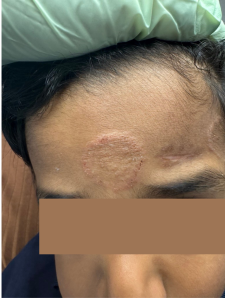

Meet one of our youngest patients—a sweet 3-month-old baby girl who came to our pediatric dermatology clinic with a small, firm, yellowish bump on her cheek. Her parents noticed it had slowly grown over the past few weeks, but their otherwise healthy infant showed no signs of discomfort. There were no complications during pregnancy or delivery, and her older sibling is unaffected.
Upon clinical examination, the lesion was classic in appearance: a solitary, dome-shaped, well-demarcated papule with a slightly orange hue. A clinical diagnosis of juvenile xanthogranuloma (JXG) was made—one of the most common non-cancerous skin conditions in infants seen in pediatric dermatology.
Juvenile xanthogranuloma is a benign infant skin lesion caused by an overgrowth of dermal dendritic histiocytes. It typically affects babies and young children, with most lesions appearing on the head, neck, or upper body. Although the name may sound intimidating, JXG is usually harmless and self-resolving—requiring no treatment in most cases.
• Typically appears within the first year of life
• No known genetic or familial pattern (as in this case, where the sibling is unaffected)
• Lesions are usually solitary but can occasionally be multiple
• Most resolve spontaneously over time, often without scarring
• Rare systemic involvement (such as eye involvement) is more likely when multiple lesions are present or in children with neurofibromatosis type 1 (NF1)
In this patient’s case, the skin lesion will be monitored with regular follow-up visits. No biopsy or treatment is needed at this time. Her story is a reminder that not all skin bumps in babies are dangerous, and specialized pediatric dermatologic evaluation can help families avoid unnecessary worry.
Disclaimer: These are real patient cases shared for educational purposes with express written consent. All patient images and stories are the property of Dermatology Solutions and may not be reproduced or distributed without permission.